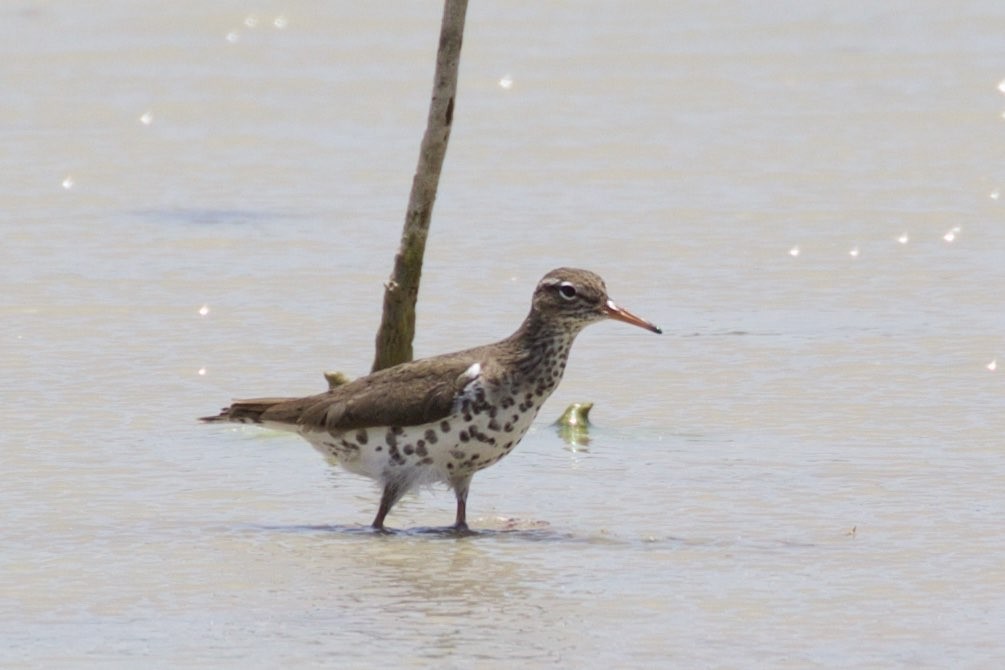Spotted Sandpiper
A species of Common and Spotted Sandpipers Scientific name : Actitis macularius Genus : Common and Spotted Sandpipers
Spotted Sandpiper, A species of Common and Spotted Sandpipers
Botanical name: Actitis macularius
Genus: Common and Spotted Sandpipers
Content
Description People often ask General Info
Description
The spotted Sandpiper has a unique social structure compared to most birds. Males raise the young while females forage for food along the shoreline. The bird is often solitary and is identifiable by its bobbing tail. The shorebird also puts on a notable courtship dance. During the breeding season, females take up to four mates.
Size
19 cm (7.5 in)
Colors
Brown
Black
White
Life Expectancy
12 years
Nest Placement
Ground
Clutch Size
3 - 5 eggs
Incubation Period
1 - 5 broods
Number of Broods
19 - 22 days
Feeding Habits
Spotted Sandpiper's diet mainly consists of invertebrates such as midges, mayflies, flies and their larvae, grasshoppers, beetles, worms, snails, small crustaceans, and fish, occasionally scavenging dead fish. Spotted Sandpiper forages actively by probing, lunging, picking off plants, or capturing flying insects, often with characteristic nodding behavior.
Habitat
Spotted Sandpiper predominantly inhabit areas close to water, such as pebbly lake shores, streamsides, and in winter, seashores including beaches and mangroves. These adaptable birds are found in diverse habitats across North America, from freshwater rivers to mountain streams at altitudes up to 14,000 feet, as well as coastal and forest regions up to 6,000 feet in Central and South America during winter. Their breeding environment typically includes a shoreline, a semi-open nesting area, and dense vegetation for chick shelter.
Nest Behavior
Nest building by spotted Sandpiper is part of courtship, with multiple initial attempts rarely completed. The final nest is made post-courtship, started by the female and often finished by the male. They favor nesting near Common Tern colonies when available.
Nest Characteristics
Spotted Sandpiper constructs its nest near water, typically within 100 yards of the shore and under broad-leaf plant shade. The nest is a 2–3 inch depression in the soil, lined with dead grass and woody material, possibly hidden under thicker vegetation in predator-rich areas.
Dite type
Carnivorous
People often ask
General Info
Feeding Habits
Bird food type
Sounds
Call
Recording location: Venezuela
Behavior
Spotted Sandpiper exhibit unique behaviors that distinguish them from other bird species. They are busy foragers, often seen walking with a meandering gait along water edges and then abruptly pursuing prey, with their tails characteristically bobbing. In flight, spotted Sandpiper present a low, erratic pattern over water, alternating rapid wingbeats with short glides. An atypical aspect of their social structure is the reversed sexual roles; the more diminutive and less confrontational males assume parental duties by nesting and nurturing the young. In contrast, the more robust females claim territories and frequently engage in polyandry, mating with multiple males. Each male within the female's domain diligently guards his smaller territory against rivals. This reversal in parental roles may be linked to higher levels of prolactin in males, which fosters their nurturing behavior. During courtship, females showcase an impressive aerial performance or engage in a striking display on the ground, seeking mates across expansive shorelines. Males receptive to these advances stay within the territory, while those uninterested are actively repelled.
Distribution Area
Spotted sandpipers are a philopatric species. Their breeding habitat is near fresh water across most of Canada and the United States. They migrate to the southern United States, the Caribbean, and South America, and are very rare vagrants to western Europe. These are not gregarious birds, and are seldom seen in flocks. Spotted sandpipers are the most widespread species of their kind in North America due to their high breeding rates and their ability to adapt to various environmental pressures. 
Species Status
Although there has been some decline in the population of spotted sandpipers, their conservation status is currently of least concern. However, the decrease of spotted sandpipers is not projected to slow or stop in the future. The destruction of their natural habitats due to increasing wildfires causes problems for breeding and raising offspring. Additionally, the gradual increase in temperatures poses a problem for newborn sandpipers. 
